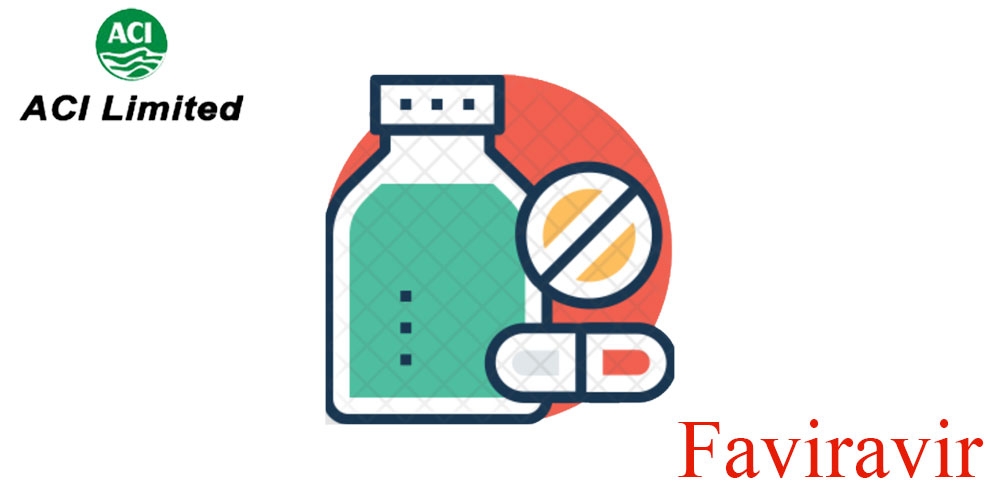ঔষধের বিস্তারিত বা বিকল্প ঔষধ জানতে ঔষধের নাম দিয়ে সার্চ দিন। যেমন- Napa বা Alatrol বা Amodis
Faviravir 200mg
TabletFavipiravir
ACI Pharmaceuticals
Other Strength:
Alternative:
- Viraflu tablet 200mg
- Piravir 200mg
- Akarvia 200mg
- Favinil™ 200mg
- Favilar 200mg
- Favigan 200mg
- Unifav 200mg

Faviravir
Composition
Faviravir200 mg tablet: Each film coated tablet contains Favipiravir INN 200 mg.
Pharmacology
Faviravir is the preparation of Favipiravir which is metabolized in cells to a ribosyl triphosphate form (Favipiravir RTP) and that Favipiravir RTP selectively inhibits RNA polymerase involved in influenza viral replication. With regards to the activity against human DNA polymerases α, β and γ, Favipiravir RTP (1000 μmol/L) showed no inhibitory effect on α, 9.1-13.5% inhibitory effect on β and 11.7- 41.2% inhibitory effect on γ. Inhibitory concentration (IC50) of Favipiravir RTP on human RNA polymerase II was 905 μmol/L.
Indication
Faviravir is indicated for novel or re-emerging influenza virus infections (limited to cases in which other anti-influenza virus agents are not effective or insufficiently effective).
Dose and administration
The usual dosage of Faviravir for adults is 1600 mg orally twice daily for 1 day followed by 600 mg orally twice daily for 4 days. The total administration period should be 5 days.
Contraindication
Favipiravir is contraindicated in patients who are hypersensitive to the active substance favipiravir or to any of the excipients.
Warning and precaution
The administration should be started promptly after the onset of influenza-like symptoms.Careful administration (favipiravir should be administered with care in the following patients). Patients with gout or a history of gout, and patients with hyperuricaemia (blood uric acid level may increase, and symptoms may be aggravated). Important precautions No clinical study has been conducted to examine the efficacy and safety of favipiravir with the approved dosage. The approved dosage was estimated based on the results of a placebo-controlled phase I/II clinical study in patients with influenza virus infection and the pharmacokinetic data from Japanese and overseas studies. Increase of plasma level of favipiravir has been reported in patients with liver function impairment in pharmacokinetic study conducted outside of Japan.Although the causal relationship is unknown, psychoneurotic symptoms such as abnormal behavior after administration of anti-influenza virus agents including favipiravir have been reported. For the treatment of children and minors, as a preventive approach in case of an accident due to abnormal behavior such as fall, patients/their family should be instructed that, after the start of treatment with anti-influenza virus agents, (i) abnormal behavior may be developed, and (ii) guardians and others should make an arrangement so that children/minors are not left alone for at least 2 days when they are treated at home. Since similar symptoms associated with influenza encephalopathy have been reported, the same instruction as above should be given. Influenza virus infection may be complicated with bacterial infections or may be confused with influenza-like symptoms. In case of bacterial infection or suspected to be bacterial infection, appropriate measures should be taken, such as administration of anti-bacterial agents.
Side effects
The most common side effects of favipiravir are shock, anaphylaxis, pneumonia, hepatitis fulminant, hepatic dysfunction, jaundice, toxic epidermal necrolysis , oculomucocutaneous syndrome (Stevens-Johnson syndrome), acute kidney injury, white blood cell count decreased, neutrophil count decreased, platelet count decreased, neurological and psychiatric symptoms (consciousness disturbed, abnormal behavior, deliria, hallucination, delusion, convulsion) and colitis haemorrhagic.
Use in pregnancy and lactation
Pregnancy: Do not administer favipiravir to women known or suspected to be pregnant. Lactation: When administering favipiravir to lactating women, instruct to stop lactating. (The major metabolite of favipiravir, a hydroxylated form, was found to be distributed in breast milk).
Drug interaction
DrugsSigns, symptoms andtreatmentMechanism and risk factorsBlood uric acid level increases. When pyrazinamide 1.5 g once daily and favipiravir 1200 mg/ 400 mg BID were administered, the blood uric acid level was 11.6 mg/dL when pyrazinamide was administered alone, and 13.9 mg/dL in combination with favipiravir.Reabsorption of uric acid in the renal tubule is additively enhanced.Blood level of repaglinide may increase, and adverse reactions to repaglinide may occur.Inhibition of CYP2C8 increases blood level of repaglinide.PyrazinamideRepaglinideBlood level of favipiravir may increase, and adverse reactions to favipiravir may occur.Interaction with XO may increase blood level of favipiravir.TheophyllineEfficacy of these drugs may be reduced.Inhibition of AO by favipiravir may decrease blood level of active forms of these drugs.FamciclovirSulindac
Overdose
There is limited clinical experience with favipiravir overdose in humans. Storage
Store in a cool (below 30°C) and dry place protected from light. Keep away from the reach of children.
Packing
Faviravir200 mg tablet: Each box contains 20 tablets in Alu-Alu blister pack
এই পাতাটি ১২৯ বার দেখা হয়েছে
রাজডক কী?
ফ্রী সদস্য হোন Click Here
ডাক্তার হিসাবে যোগদান করতে Click Here
নার্স / টেকনোলজিস্ট হিসাবে যোগদান করতে Click Here
ফ্রী সদস্য হোন Click Here
ডাক্তার হিসাবে যোগদান করতে Click Here
নার্স / টেকনোলজিস্ট হিসাবে যোগদান করতে Click Here

